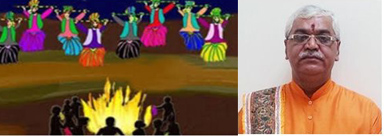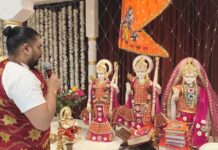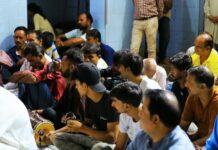 According to the Hindu calendar, Lohri falls in mid January. The earth is farthest from the sun at this point of time and starts its journey towards the sun, thus ending the coldest month Paush Masa of the year, and announcing the start of the month of MaghMasa, the auspicious period of Uttarayan. (January 12/13 as per the Gregorian calendar).
According to the Hindu calendar, Lohri falls in mid January. The earth is farthest from the sun at this point of time and starts its journey towards the sun, thus ending the coldest month Paush Masa of the year, and announcing the start of the month of MaghMasa, the auspicious period of Uttarayan. (January 12/13 as per the Gregorian calendar).
It is during this time that the farm fields gleam with wheat, the primary North Indian crop. Though there are different stories about the origin of Lohri, it has generally been accepted that the occasion has always been celebrated as a harvest festival. According to the Bhagawad Gita, Lord Krishna manifests himself in his full magnificence during this time.
Lohri is a festival dedicated to fire and the sun god. The celebration of Lohri marks the time when the sun shines from the Uttarayan, meaning sun travels across Makar (the zodiac sign Capricorn) and moves northwards. This alteration of the sun’s position lessens the severity of the winter season and the earth begins receiving warmth and bringing comfort to her inhabitants.
Lohri celebration marks nightlong festivities that include people lighting bonfires to combat the chilly weather, and singing and dancing around it in a festive mood. This Lohri fire symbolizes the sun and is seen as a source of energy and spiritual strength. It is worshipped as a deity with food-offerings consisting of peanuts, popcorn and sweets made of til-chirva, gajak and revri.
The observation of Lohri has the dual purposes of celebrating the annual harvest and appeasing the sun-god. Both of these events have tremendous importance in the lives of North Indians, especially those belonging to its agrarian society. Farmers form a major part of the celebrants of Lohri. Both Sikhs and Hindus in the North Indian states of Punjab, Haryana, Delhi and some areas of Himachal Pradesh celebrate this festival with utmost enthusiastism and religious fervor.
This winter festival is also celebrated in many other states of India under different names. In Bengal, Karnataka, Andhra Pradesh the occasion is observed as Makar Sankranti, as Magha Bihu in Assam, and as Tai Pongal in Kerala.
A similar celebration of the annual harvest, Pongal, occurs in Tamil Nadu. Although, it is observed under different names, the underlying purpose of its celebration remains expressing gratitude to the almighty for his blessings in the form of bounteous harvest and comfortable weather conditions.
In the morning, people make a small image of the Lohri goddess with gobar (cattle dung), decorate it, and kindle a fire beneath it and chanting its praises. In the evening, people light a large bonfire at sunset, toss sesame seeds, gur, sugar-candy and rewaries in it, sit round it, sing, and dance till the fire dies out.
People take dying embers of the fire to their homes and keep the fire going round the clock by using cow-dung cakes. People believed that the flames of the fires they lit will take their message to the sun-god, and on the next day, the sun’s rays suddenly turn warm and take the chill out of people’s bones.
Another reason behind the origin of Lohri is that, in olden times, human beings lit fires to keep away flesh-eating animals and protect their habitations. Everyone contributes to this communal fire by giving cow-dung cakes to young boys and girls who collect them for a month by going around in the villages.
Lohri is also associated with weddings. Many Lohri songs are based on the old love story of Dulla Bhatti who rescued a girl from her cruel abductors and adopted her. Finally he arranged for her marriage.
These songs tell the present youth to protect the honor of their sisters and daughters, and punish those who try to dishonor them.
On the occasion of Lohri and Makara Sankranti, Pandit Anil Joshi of Hindu Mandir of Lake County blesses and wishes everyone a prosperous New Year and happy Lohri and Sankranti.






